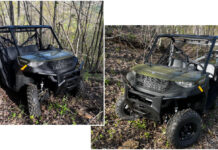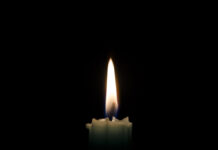I used to wear one of my headlamps only when we had a power outage or when I was working in the crawl space or the attic. I would rarely wear one if I went outside carrying a shotgun to see what went bump in the night.
Now I wear one every night when walk the dog. That’s when the rechargeable batteries come in handy.
Every night, I walk the dog sometime between 10 p.m. and 1 a.m. At first, I used my EDC flashlight, a 1,200 lumen handheld torch that uses an 18650 battery. I quickly switched over to one of my headlamps that uses two 18650s and has three brightness settings. When the brightest setting and the medium setting are about the same, I know it’s time to recharge the batteries.
Multiple Headlamps
I have at least three powerful headlamps that use 18650 batteries and bright LEDs. One of them is in my car’s survival kit along with a charger that can run off the 12-colt power outlet. All three headlamps are adjustable, which is important. If you use a bright light when working on something close at hand, the bounce-back will be blinding. If I was changing a tire or looking at something under the hood, I would want a lower setting.
On the other hand, when I am walking the dog, I leave it on the highest setting. This allows me to see all the way to our fence line and illuminates the entire driveway. I treat these walks as a patrol, and we walk the length of our property and circumnavigate the fenced garden and chicken run. Hopefully, the bright light and the dog will give any predators with a taste for chicken second thoughts. I also want to see any serious threat in time to draw my pistol.
If you are reading, cooking, or doing other inside work in pitch darkness, you will want to use the very lowest setting or a much a smaller light with a lower brightness rating. Many of these low-power headlamps use AA or AAA batteries and can be quite inexpensive at the big box stores. Because they are inexpensive, you should buy several. First, they might not last. Second, they are good to hand out to anyone that ends up bugging out to your place. Third, I expect they would make excellent barter goods in an end-of-the-world scenario.
Adjustability Matters
My of my more expensive lights have two different kinds of adjustments. Most of them have three to six settings and by sliding or turning a switch, I can click from low to high and back down again. One of them has a slide that allows me to pick any location between dim and bright. This light also has the option of switching to a blue or red LED. Red is useful because it allows you to see but will not ruin your night vision. It is also far less likely to be detected by an opposing force than a bright white light. Blue is useful for seeing blood at night and might be helpful in a hunting situation.
It’s also important to have a headlamp that can adjust up or down, so you can redirect the angle for close work or distant use. This is a feature of the larger lights, but often is not available in the inexpensive models.
Sometimes headlamps and even handheld flashlights have a setting that will blink SOS or some other pattern. I think these are both useless and annoying. A strobe setting is better, but probably of more value in a tactical flashlight than on a headlamp.
Rechargeable Batteries
In a post-SHTF scenario where there is no electricity, your headlamp will be critical in allowing you to operate at night, both indoors and out. The hands-free advantage cannot be under estimated. While I stock a couple hundred batteries, the rechargeables are going to have the most value in a pure survival situation.
I load my lights with rechargeable batteries, either my favorite 18650s, or a NiMH AA or AAA battery. Then I carry a set or two of primary (meaning on-rechargeable) batteries with me in case I have to make a battery change on the run, with no time to recharge. Most lights that accept the 18650 can also use two CR123s (Just don’t stick them in your charger). These have a shelf life of 10 years, so buy them in a pack of 50 to save money and ensure yourself a good supply.
In my bugout bag, I have a foldable solar charger than can recharge batteries or phones. It has both a USB output and a 12-volt outlet. It includes MOLLE straps so you can attach it to the top of your pack and charge your batteries while you are on the move during the day.
Brands and Pricing
My favorite headlamps are the NiteCore HC60, which costs about $60) and HC90, which costs about $100. I’ve had this for several years. If I were to buy a new one today, I might go with to the HC65 or even the HC33, which a friend of mine has.
On the dimmer end of the spectrum, say 50 to 200 lumens, I rely on lights by Princeton Tec, but I would not hesitate to buy a Streamlight Enduro. These lights are in the $20 to $40 range, depending on their size and features.
You will see lots of headlamps sold by the battery companies like Energizer and Rayovac. I am unimpressed with these. I think they package them with their batteries to market their batteries. They are better than nothing, but you often get what you pay for. In my experience, a $60 light that includes a $10 18650 battery is well over six times better than a $10 light that includes three AAA batteries. (I also prefer devices with two AA batteries over those with three AAAs.)
The Downside of Headlamps
As useful as a headlamp can be, it’s not perfect for every situation. Wearing a headlamp can make you a glaring target if you are in a position where someone is out to get you. At the very least, it pinpoints your position. At worst, it gives someone a very clear aiming point.
In my daily use, the most common downside of having a bright light mounted two inches above my eyes is it attracts nighttime bugs straight to my head. I’ve had them hit me in the face, and one ever flew into my shirt. It’s enough to make me wish for cold weather!
You also have to be careful how you reach up to turn your headlamp on and off. I have learned to keep my hand away from the lens, otherwise the light reflecting off my hand can be blinding. This is one example of why it is a good idea to wear and practice with your survival gear before you need it in an emergency.
As the world around us seems to deteriorate, and as the danger of power outages, brownouts and blackouts grows for much of the country, make sure you have several headlamps in your stash.







